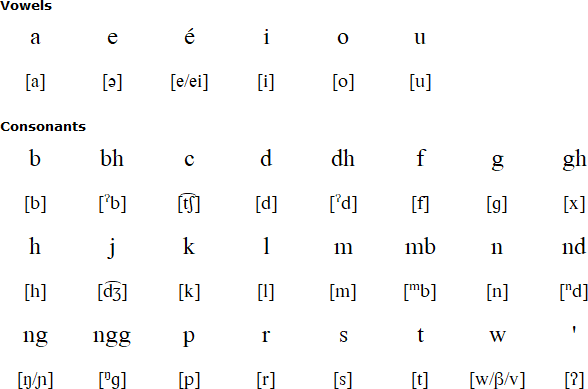Kéo is a member of the Sumba-Flores branch of the Malayo-Polynesian language family. It is spoken by about 40,000 people on the island of Flores in the Ngada Regency of Nusa Tenggara Timur Province in eastern Indonesia.
Kéo is also known as Nagé-Kéo, Nage-Keo, Bahasa Ke'o or Bahasa Bajawa. Native speakers call it sara kita ("our language") or sara ndai ("the language here"), and themselves 'ata Kéo (Kéo people). Nage is the name of an ethnic group who live near the Kéo people. Their language is either closely related to Kéo, or a variety of the same language.

Download an alphabet chart for Kéo (Excel)
The letter h appears only in loanwords and proper names.
Méo né'é wawi 'imu rua mindawoé pawé. Nambu ha ndeka méo punu né'é wawi: "Rembu kita ta muri ndia wawo tana ta so'o mbani tungga manusia."
The cat and the pig, those two were good friends. At one time the cat spoke with the pig: "Of all of us who live here upon the earth, those that are the most fierce are only humans."
Sample text provided by Michael Peter Füstumum
Information about Kéo
https://en.wikipedia.org/wiki/Kéo_language
https://openresearch-repository.anu.edu.au/handle/1885/9446
Dhao, Ende, Hawu, Kambera, Kéo, Lio, Manggarainese, Ngadha, Palu’e, Rongga, Wejewa
Languages written with the Latin alphabet
Page created: 07.10.22. Last modified: 26.09.23
[top]
You can support this site by Buying Me A Coffee, and if you like what you see on this page, you can use the buttons below to share it with people you know.

If you like this site and find it useful, you can support it by making a donation via PayPal or Patreon, or by contributing in other ways. Omniglot is how I make my living.
Note: all links on this site to Amazon.com, Amazon.co.uk
and Amazon.fr
are affiliate links. This means I earn a commission if you click on any of them and buy something. So by clicking on these links you can help to support this site.
[top]